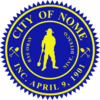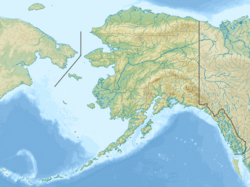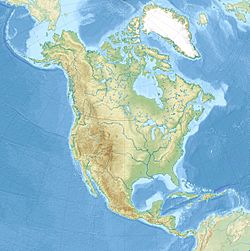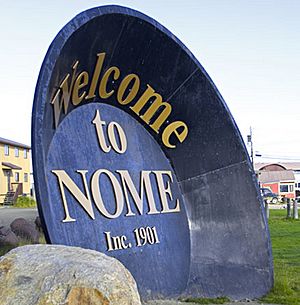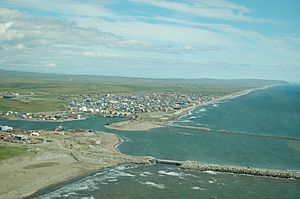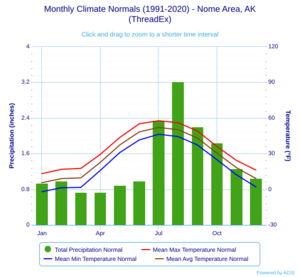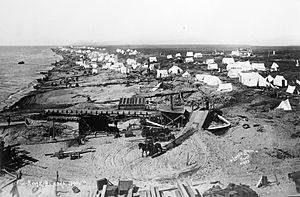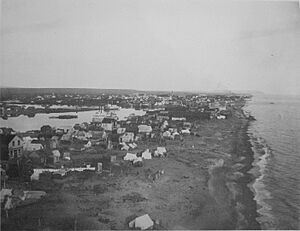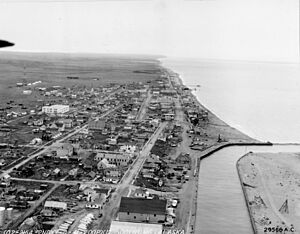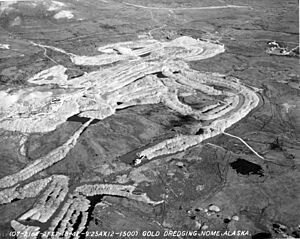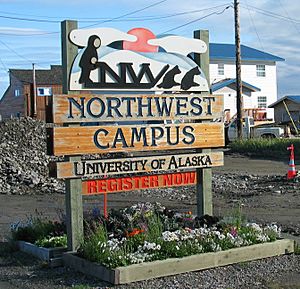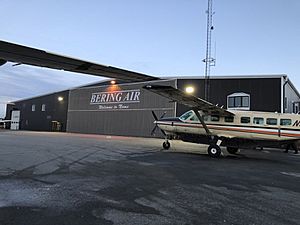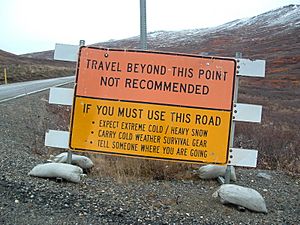Nome, Alaska facts for kids
Quick facts for kids
Nome
Sitŋasuaq (Inupiaq)
|
||
|---|---|---|
| City of Nome | ||
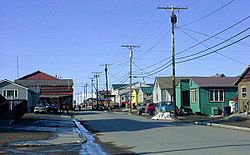
Steadman Street in Nome, looking north from King Place, in May 2002
|
||
|
||
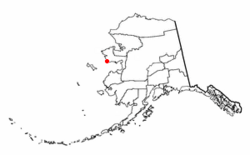
Location of Nome, Alaska
|
||
| Country | United States | |
| State | Alaska | |
| Census Area | Nome | |
| Incorporated | April 12, 1901 | |
| Founded by | Jafet Lindeberg, Erik Lindblom, and John Brynteson | |
| Government | ||
| • Type | Council-Manager | |
| Area | ||
| • Total | 21.49 sq mi (55.7 km2) | |
| • Land | 12.80 sq mi (33.2 km2) | |
| • Water | 8.69 sq mi (22.5 km2) | |
| Elevation | 20 ft (6 m) | |
| Population | ||
| • Total | 3,699 | |
| • Density | 289.01/sq mi (111.59/km2) | |
| • Demonym | Nomeite Noman | |
| • Census Area | 9,492 | |
| Time zone | UTC−9 (Alaska (AKST)) | |
| • Summer (DST) | UTC−8 (AKDT) | |
| ZIP Code |
99762
|
|
| Area code | 907 | |
| FIPS code | 02-54920 | |
| GNIS IDs | 1407125, 2419435 | |
Nome is a city in Alaska, a state in the United States. It is located on the southern coast of the Seward Peninsula, right on the Bering Sea. In 2020, about 3,699 people lived there. Nome became an official city on April 9, 1901. It was once the biggest city in Alaska!
Nome is also known as Sitŋasuaq in the local Iñupiat language. Before settlers arrived, the Iñupiat people lived here. In 1898, three men found gold on the beaches of Nome. This started the famous Nome Gold Rush. Thousands of people rushed to the area, and Nome quickly grew.
A very important event happened in Nome in 1925. A serious illness called diphtheria spread among the people. Bad weather made it impossible to fly in medicine. So, brave dog sled teams carried the life-saving medicine across Alaska. This amazing journey is now remembered by the Iditarod Trail Sled Dog Race, which finishes in Nome every year.
Today, Nome's economy still relies on gold mining, especially offshore. The city also claims to have the world's largest gold pan!
Contents
- What's in a Name? The Story of Nome's Name
- Nome's Location and Weather
- Who Lives in Nome? Population and People
- Nome's History: From Gold Rush to Dog Sleds
- Nome's Economy: Gold and More
- Learning in Nome: Schools and Education
- Media and News in Nome
- Getting Around Nome: Transportation
- Healthcare in Nome
- Famous People from Nome
- Images for kids
- See also
What's in a Name? The Story of Nome's Name
The name "Nome" has a few interesting stories behind it. No one is completely sure how the city got its name.
Three Theories About Nome's Name
One idea is that Jafet Lindeberg, who helped found Nome, named it. He was from Norway, and there are places in Norway called Nome.
Another theory says the name came from a mistake. A British mapmaker was copying a map. A British officer had written "? Name" next to a cape that didn't have a name. The mapmaker might have misread it as "C. Nome" (for Cape Nome). The city then took its name from this cape.
A third idea is that the name came from a misunderstanding of a local Inupiaq word. The word Naami means "Where at?" Perhaps visitors heard this word and thought it was the name of the place.
Changing the Name to Anvil City
In 1899, some local miners and business owners wanted to change the city's name to Anvil City. They thought it would be less confusing since there was also a Cape Nome and a Nome River nearby. But the United States Post Office in Nome said no. They worried the post office might move to another mining camp called Nome City. So, the name was changed back to Nome.
Nome's Location and Weather
Nome is located at 64.5 degrees North and 165.4 degrees West. The city covers about 21.6 square miles (56 square kilometers). About 12.5 square miles (32 square kilometers) is land, and 9.1 square miles (24 square kilometers) is water.
Nome's Climate: Cold Winters and Cool Summers
Nome has a subarctic climate. This means it has long, very cold winters and short, cool summers. Because Nome is on the coast, the ocean helps to make the weather a bit milder. Winters are not as harsh as in inland Alaska. Summers are also not very hot.
January is usually the coldest month. Temperatures can drop to 0°F (-18°C) or lower for many days. The warmest month is July, with an average temperature of about 52°F (11°C). It rarely gets as hot as 80°F (27°C).
Nome gets a lot of snow, averaging about 82.8 inches (210 cm) per season. Snow usually starts in October and can last until May. Most of the rain falls in the summer months. The average temperature for the whole year is about 28°F (-2°C).
| Climate data for Nome Airport, Alaska (1991–2020 normals, extremes 1906–present) | |||||||||||||
|---|---|---|---|---|---|---|---|---|---|---|---|---|---|
| Month | Jan | Feb | Mar | Apr | May | Jun | Jul | Aug | Sep | Oct | Nov | Dec | Year |
| Record high °F (°C) | 51 (11) |
48 (9) |
44 (7) |
60 (16) |
78 (26) |
86 (30) |
86 (30) |
83 (28) |
71 (22) |
59 (15) |
50 (10) |
44 (7) |
86 (30) |
| Mean daily maximum °F (°C) | 13.2 (−10.4) |
16.8 (−8.4) |
17.6 (−8.0) |
29.4 (−1.4) |
43.6 (6.4) |
55.1 (12.8) |
57.7 (14.3) |
56.0 (13.3) |
49.0 (9.4) |
36.0 (2.2) |
24.3 (−4.3) |
16.2 (−8.8) |
34.6 (1.4) |
| Daily mean °F (°C) | 5.6 (−14.7) |
9.0 (−12.8) |
9.6 (−12.4) |
22.7 (−5.2) |
37.3 (2.9) |
48.3 (9.1) |
52.0 (11.1) |
50.2 (10.1) |
43.1 (6.2) |
30.4 (−0.9) |
18.2 (−7.7) |
9.1 (−12.7) |
28.0 (−2.2) |
| Mean daily minimum °F (°C) | −2.0 (−18.9) |
1.3 (−17.1) |
1.6 (−16.9) |
15.9 (−8.9) |
30.9 (−0.6) |
41.5 (5.3) |
46.3 (7.9) |
44.4 (6.9) |
37.2 (2.9) |
24.9 (−3.9) |
12.2 (−11.0) |
2.0 (−16.7) |
21.4 (−5.9) |
| Average precipitation inches (mm) | 0.94 (24) |
0.99 (25) |
0.74 (19) |
0.74 (19) |
0.89 (23) |
0.99 (25) |
2.35 (60) |
3.22 (82) |
2.20 (56) |
1.84 (47) |
1.27 (32) |
1.05 (27) |
17.22 (437) |
| Average snowfall inches (cm) | 13.4 (34) |
14.7 (37) |
10.7 (27) |
6.8 (17) |
1.9 (4.8) |
0.2 (0.51) |
0.0 (0.0) |
0.0 (0.0) |
0.5 (1.3) |
4.7 (12) |
12.1 (31) |
15.8 (40) |
80.8 (205) |
| Average precipitation days | 10.0 | 10.5 | 8.8 | 7.9 | 8.8 | 8.7 | 12.6 | 14.8 | 13.6 | 12.9 | 11.0 | 11.4 | 131.0 |
| Average snowy days | 11.0 | 11.4 | 9.8 | 7.6 | 2.8 | 0.2 | 0.0 | 0.0 | 0.8 | 5.5 | 10.5 | 12.3 | 71.9 |
| Source: NOAA (sun, relative humidity, and dew point 1961–1990, snow depth 1981–2010)) | |||||||||||||
| Climate data for Coastal sea temperature for Nome, Alaska | |||||||||||||
|---|---|---|---|---|---|---|---|---|---|---|---|---|---|
| Month | Jan | Feb | Mar | Apr | May | Jun | Jul | Aug | Sep | Oct | Nov | Dec | Year |
| Daily mean °F (°C) | 28.9 (−1.7) |
28.9 (−1.7) |
28.9 (−1.7) |
28.9 (−1.7) |
30.7 (−0.7) |
43.0 (6.1) |
50.5 (10.3) |
51.4 (10.8) |
47.7 (8.7) |
41.2 (5.1) |
31.8 (−0.1) |
29.5 (−1.4) |
36.8 (2.7) |
| Source: Seatemperature.org | |||||||||||||
Who Lives in Nome? Population and People
| Historical population | |||
|---|---|---|---|
| Census | Pop. | %± | |
| 1900 | 12,488 | — | |
| 1910 | 2,600 | −79.2% | |
| 1920 | 852 | −67.2% | |
| 1930 | 1,213 | 42.4% | |
| 1940 | 1,559 | 28.5% | |
| 1950 | 1,876 | 20.3% | |
| 1960 | 2,316 | 23.5% | |
| 1970 | 2,357 | 1.8% | |
| 1980 | 2,301 | −2.4% | |
| 1990 | 3,500 | 52.1% | |
| 2000 | 3,505 | 0.1% | |
| 2010 | 3,598 | 2.7% | |
| 2020 | 3,699 | 2.8% | |
| US Decennial Census | |||
Nome first appeared in the US Census in 1900. It had 12,488 residents then, making it the largest community in Alaska. Most residents were White, but there were also Native, Asian, and Black people.
After the gold rush, Nome's population dropped. By 1910, it had only 2,600 residents. It continued to change over the years.
In 2000, Nome had 3,505 people. About half of the people were Native American (mostly Iñupiat). The other half were mostly White, with smaller groups of Asian, Black, and other races. Many households in Nome have children.
The people of Nome are a mix of Iñupiat Eskimos and non-Natives. Many people still rely on traditional activities like hunting and fishing. The Nome Eskimo Community is a recognized tribe here.
Nome's History: From Gold Rush to Dog Sleds
Before the Gold Rush
The Inupiat people have hunted and lived on the west coast of Alaska for thousands of years. There is evidence that an Iñupiat settlement called Sitnasuak existed in Nome before gold was found.
The Exciting Nome Gold Rush
In the summer of 1898, three men discovered gold on Anvil Creek. They were called the "Three Lucky Swedes." News of this discovery quickly spread. By 1899, Nome's population exploded to 10,000 people.
Then, gold was found in the beach sands along the coast of Nome. This made even more people rush to the area. Thousands arrived by steamship from Seattle and San Francisco in 1900. A huge tent city stretched for 30 miles (48 km) along the coast. In June 1900, about 1,000 new people arrived in Nome every day!
Some people tried to steal mining claims from the original discoverers. This led to legal battles. The story of these struggles was even made into a famous novel called The Spoilers. It was later turned into several movies, including two starring John Wayne.
During the gold rush, Nome was the largest city in the Alaska Territory. The U.S. Army even had to make sure everyone had a place to stay for the harsh winter. By 1910, Nome's population had dropped to 2,600.
Fires and strong storms destroyed many of Nome's old buildings from the gold rush era.
The Great Serum Run of 1925
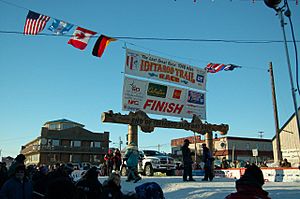
In 1925, Nome became famous for the "Great Race of Mercy." A serious diphtheria outbreak hit the area. The only way to get the life-saving medicine (antitoxin serum) to Nome was by dog sled. Airplanes couldn't fly because of terrible blizzards.
Many dog sled teams worked together in a relay to deliver the serum. The last part of the journey was led by Gunnar Kaasen and his lead dog, Balto. Another dog, Togo, led the longest and most dangerous part of the relay.
Today, the annual Iditarod Trail Sled Dog Race follows a similar route. It starts in Anchorage and finishes in Nome, honoring the brave dogs and mushers of the 1925 serum run. You can even find a statue of Balto in Central Park, New York City.
Nome in World War II and Beyond
During World War II, Nome was an important stop for planes flying from the United States to the Soviet Union. An airstrip was built, and troops were stationed there.
Gold mining continued to be important for Nome's economy. In 1995, Nome got connected to the internet!
Nome's Economy: Gold and More
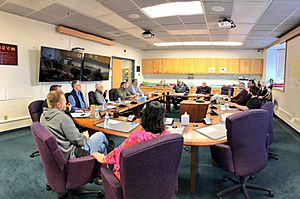
Gold mining is still a very important part of Nome's economy. It provides many jobs and brings in money. In recent years, the price of gold has gone up. This has led to more interest in finding gold offshore, under the sea.
The Discovery Channel even has a TV show called "Bering Sea Gold." It shows people using special equipment to dredge for gold from the ocean floor, even in winter by drilling holes in the ice.
Learning in Nome: Schools and Education
Higher Education Opportunities
The University of Alaska Fairbanks has a campus in Nome. It's called the Northwest Campus. It offers college courses and programs for students in the region.
Public Schools in Nome
Nome has its own public school system, called Nome Public Schools. Over 720 students attend these schools:
- Anvil City Science Academy: This is a special charter school for grades 5–8.
- Extensions Correspondence School: This school helps students learn from a distance.
- Nome-Beltz Junior/Senior High School: This school serves students in grades 7–12.
- Nome Elementary School: This school is for younger students, from kindergarten to grade 6.
- Nome Youth Facility: This facility also provides education.
Private Schools in Nome
Nome also has a private school called Nome Adventist School. It teaches students from grades 1 through 9.
Media and News in Nome
Nome has several radio stations, including KNOM and KICY. There's also a repeater for Fairbanks' KUAC.
Cable television and internet services are provided by GCI. Nome also has a few local TV stations.
Nome is home to Alaska's oldest newspaper, the Nome Nugget.
Getting Around Nome: Transportation
Airports Serving Nome
Nome is a key transportation hub for nearby villages. It has two state-owned airports:
- Nome Airport: This is the main airport. It has two paved runways and is located just west of the city.
- Nome City Field: This smaller airport is north of the city. It has one gravel runway and is used by smaller planes.
Nome's Seaport
Nome has a seaport that is used by both freight ships and cruise ships. It's located on the southern side of the Seward Peninsula. The harbor has docks for large cargo ships and smaller boats. It's important for bringing supplies to the community and for shipping out goods like rock and gravel.
Roads Around Nome
Local roads connect Nome to other communities like Council and Teller. These include the Nome-Council Highway, Nome-Taylor Highway, and Nome-Teller Highway. However, there are no roads that connect Nome to other major cities in Alaska. There are also no railroads in Nome.
Healthcare in Nome
Nome has local hospitals and medical centers. These include Norton Sound Regional Hospital and Nome Health Center. The hospital can provide emergency care and medical transport. Long-term care is also available. Nome is considered a regional center for emergency services.
Famous People from Nome
- Frank E. Kleinschmidt (1871–1949): An Arctic explorer and filmmaker who lived in Nome.
- Carrie M. McLain (1895–1973): A writer and teacher from Nome.
- Donny Olson (born 1953): Represents Nome in the Alaska Senate.
- Neal Foster (born 1972): Represents Nome in the Alaska House of Representatives.
- James "Jimmy" Doolittle (1896–1993): A famous U.S. Air Force General who spent part of his childhood in Nome.
Images for kids
See also
 In Spanish: Nome para niños
In Spanish: Nome para niños


